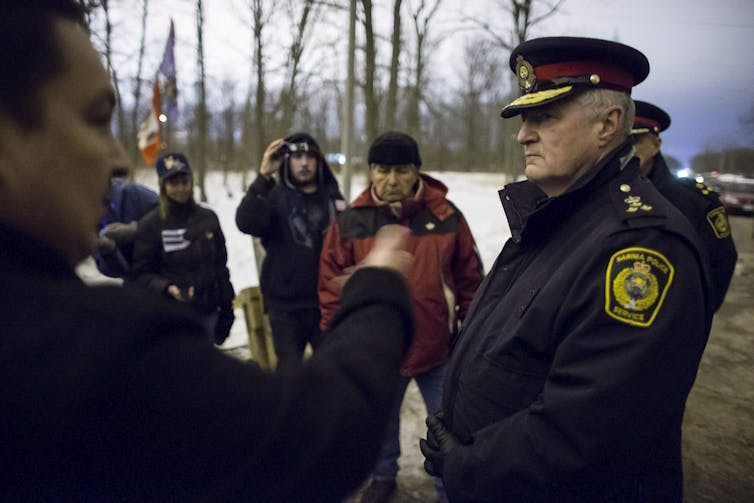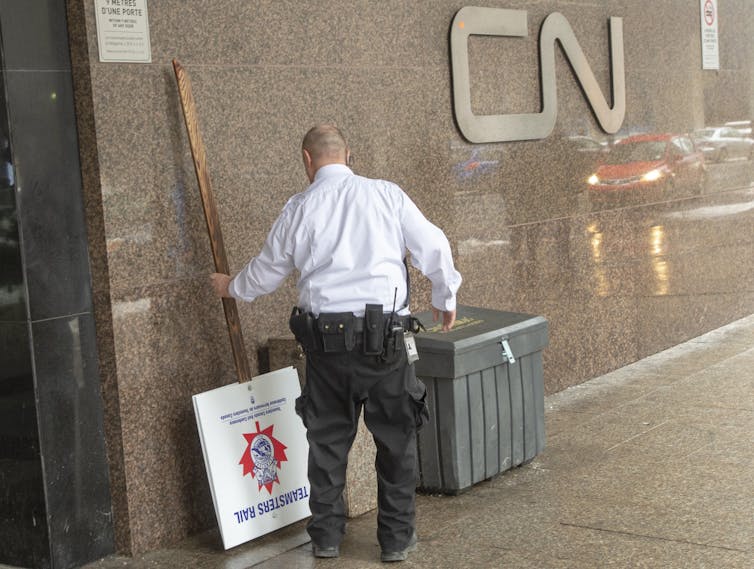By Andrew Crosby
The trains of Canada’s largest railway company have ground to a halt after some 3,200 CN Rail workers recently walked off the job.
Within the first 48 hours of the strike, provincial leaders and the private sector sounded the alarm. The premiers of Alberta, Saskatchewan and Quebec declared an “emergency” and demanded the federal government intervene and table back-to-work legislation.
The national association representing the propane industry — which relies predominantly on rail transport — issued a news release warning:
“It is critical that action is taken immediately.”
Nathalie St-Pierre, head of the association, said an extensive wait for truckers picking up propane in Sarnia, Ont., three days into the strike was “something that’s never been experienced.”
That may or may not be so, but both the propane industry and CN have a history of hostility toward disruptions to business as usual. Documents I obtained via access-to-information legislation reveal that national security officials have been preparing for such an event.
Corporations involved
During the course of conducting research for Policing Indigenous Movements, I obtained thousands of pages of internal documents. These files paint a picture of how police and government respond to protests that are framed as threats to national security, and how corporations have become integrated into efforts to protect critical infrastructure.
The Idle No More movement became a focal point for security efforts to mitigate any future economic disruptions.
In December 2012, the movement erupted across Canada. Tens of thousands of Indigenous people mobilized in response to federal legislation aimed at facilitating resource extraction which necessitated gutting environmental protections. The movement asserted treaty rights, Indigenous sovereignty and demanded that Canada engage and negotiate on a nation-to-nation basis.
In support of Attawapiskat Chief Theresa Spence’s hunger strike on Victoria Island on the Ottawa River, members of the Aamjiwnaang First Nation established a blockade of a CN spur line on their territory adjacent to “chemical valley” in Sarnia.
CN immediately sought an injunction to bring down the blockade. It was granted by Justice David Brown, a former CN lawyer and expert witness. CN sought $50,000 in financial damages for the 13-day blockade. First Nations protester Ron Plain was ordered to pay more than $16,500 in damages for being “the visible spokesperson of a protest that openly defied a court order.”
The Sarnia police force was also chastised by CN. The chief of police was summoned to court to explain why the police force did not forcefully bring down the blockade.

Briefing notes and emails produced by the RCMP — including the Critical Infrastructure Intelligence Team’s National Security Criminal Operations, which monitored Idle No More closely — acknowledged that “CN policy is to seek an injunction where a railway is blocked” and to levy indictable mischief, intimidation and trespass charges under the Railway Safety Act.
During Idle No More, the RCMP also noted that: “CN has provincewide injunctions for British Columbia, Manitoba and Saskatchewan as it relates to Aboriginal blockades.”
Industry pressure
In addition to having access to legal resources to end disruptive protests and strikes, industry pressure can also play a significant role in influencing government and security officials.
During the Aamjiwnaang rail blockade, Indigenous and Northern Affairs Canada (INAC) bureaucrats monitored social media and solicited Sarnia police for intelligence. INAC emails reveal that CN’s Manager of Aboriginal Relations asked a senior government official to intervene and request the blockade be dismantled, further noting that CN officials were “extremely frustrated” with police.
In addition to CN pressure, the Canadian Propane Association sent a letter to the minister of public safety urging the immediate removal of the blockade “before it causes serious damage to the propane industry.”
Given the role that public servants played during the Aamjiwnaang rail blockade and Idle No More in general —as peers to industry and hostile to protesters — CN workers should expect ongoing behind-the-scenes collaborations between industry, government and police throughout the course of this strike.
St-Pierre wants the federal government to declare propane an essential product for trains to move without interruption.
“When you depend on an infrastructure so important as the rail, it’s difficult to have a Plan B,” she said. Invoking the national interest and critical infrastructure sends a direct message to the federal government, which, as it turns out, has already prepared for such a contingency.

In June 2013, the Government Operations Centre — which leads and supports response co-ordination of events affecting the national interest —organized a “tabletop exercise for deputy ministers on federal response to major protests” in response to Idle No More and to prepare for future disruptions.
A memo prepared for Public Safety’s deputy minister outlined that “the scenario centres on a small and peaceful protest that will gradually escalate to a major protest occurring in several regions of the country.”
The invitees included 17 federal agencies, including INAC, the RCMP, the Canadian Security Intelligence Service and the Integrated Terrorism Assessment Centre.
Interestingly, the exercise scenario centred on the blockade of a CN rail line in southern Ontario. During the exercise, government officials co-ordinated to weigh various options and respond to different scenarios, which included pressure from the propane industry.
A debrief of the exercise indicated that:
“The scenario was not specific to First Nations protests; however, lessons learned from recent events were pulled into the discussion. The exercise started with a lawful, local protest, escalating to violent and criminal activities across Canada.”
The “violent and criminal activities” referred to as part of the table-top scenarios included the existence of a “splinter group” setting up a blockade, and solidarity blockades and protests in four provinces.
The “splinter group” category has been created by Canadian officials to refer to “dissidents” or “factions” of “Aboriginal extremists” acting outside of federally recognized Indian Act Band Council leadership.
Threats?
When negotiators are unable to end a blockade or reach an agreement during a labour disruption, it’s clear that events can be put under a national security microscope and conveniently framed as threats to critical infrastructure.
Indeed, the Aamjiwnaang rail blockade and subsequent scenario-planning exercises may have helped inform the 2015 update to the Anti-Terrorism Act and the embedded Security of Information Sharing Act (SCISA).
The SCISA facilitates the sharing of information among 17 government departments regarding “any activity that undermines the sovereignty, security or territorial integrity of Canada or the lives or the security of the people of Canada.” This type of activity includes “interference with the economic or financial stability of Canada” or “interference with critical infrastructure.”
Under these terms, strikes and blockades fall under the purview of counter-terrorism measures.
The union representing rail workers has suggested CN and others are whipping up hysteria and manufacturing a crisis in order to crush the strike. It added that enough trains were running to supply propane to Ontario and Québec, and that CN decides which products get shipped.
The strike is still ongoing. It will be interesting to see how long it will take for both government and industry to frame it as a threat to national security.
This article is republished from The Conversation under a Creative Commons license. Carleton University is a member of this unique digital journalism platform that launched in June 2017 to boost visibility of Canada’s academic faculty and researchers. Interested in writing a piece? Please contact Steven Reid or sign up to become an author.
All photos provided by The Conversation from various sources.
![]()
Sunday, November 24, 2019 in The Conversation
Share: Twitter, Facebook



